June/July 2014
Where’s the Loo?
We go From Big Ben to the Borders, with Old Friends, New Friends, Cousins & More
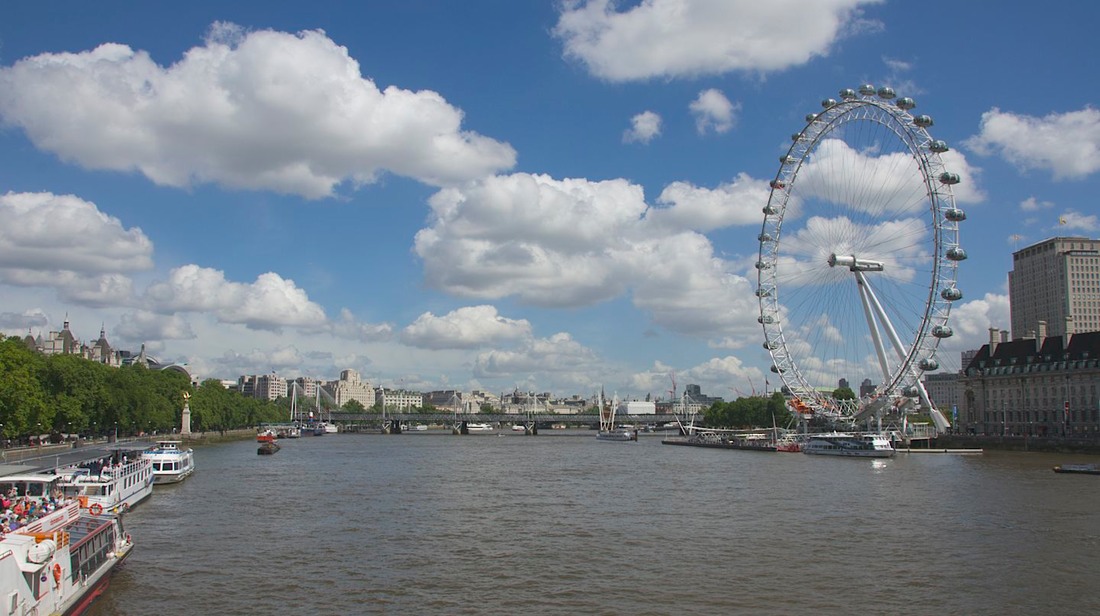
So here we were in London. We’d put off visiting for four years, but now we were finally on our way. For us, just like anyone traveling by motorhome, it took strategizing on how to make it all happen. Visiting big cities is not easy for us. Where to stay so we can safely leave the Tiger during the day? How to get in and out of the city? How long a visit did we need? All of these questions and more needed answers before we arrived.
First, we made reservations at a campground outside the city; lots of folks stay there and it really does work out very well. A new issue popped up early on in that the campsite is within the city’s beltway, an official LEZ (Low Emission Zone) area, and we needed to register the Tiger with the officials in order to get clearance to drive within The Zone. Turned out that wasn’t difficult; we were able to handle it all on line, and received Permission to Enter. It all has to do with the age and type of vehicle. But the powers that be seemed pleased to have us around and even sent us a letter to that effect. Gosh! We were proud!
Once we got settled in the campground then we had to sort out how to use the public transportation. Rather complicated, but we had lots of folks making suggestions, and the people at the campground had good advice. Rick is very good with figuring out how to use the busses and trains. After all, he got us in and out of Paris all right, didn’t he? After much discussion we purchased open-ended Oyster cards (transport passes), put a huge amount of money on them, and flung ourselves into the fray. The London transport system is impressive in operation, but cheap it isn’t.
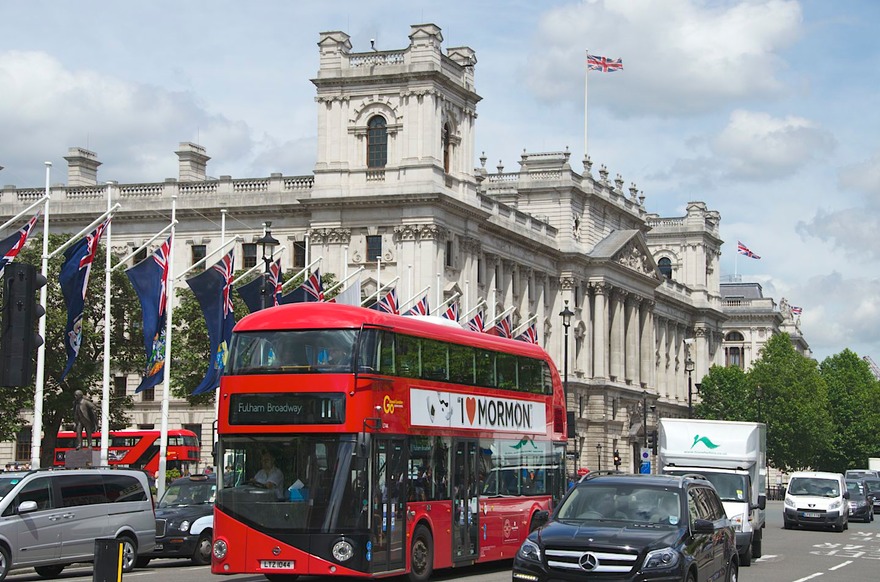
We had decided to stay for 10 days, and we went into the city six different times, leaving ourselves occasional days to catch our breath, do laundry, look at pictures, visit with the neighbors (and some Australian friends who stopped by); all that stuff. It worked out pretty well. We wouldn’t have stayed so long except we had a daughter arriving with a bunch of high school kids in tow, so we stayed a few extra days in order to meet up with her.
There are places we didn’t get to, some stuff we didn’t do that we might’ve, but we covered a lot of territory. And we had fun. We saw the British Museum and the V&A (Victoria & Albert Museum), Trafalgar Square and its inhabitants, spent a couple of hours at The National Gallery, gazed at the Parliament Buildings and Big Ben from all angles, hiked from the bus stop all the way out to Greenwich (and took a boat ride from Charing Cross to Greenwich a different day), all the usual. We tried to go to the Imperial War Museum, but it was closed until mid-July because they were installing a special exhibit on WWI. We’ll go there in the fall when we’re planning a shorter return visit.
London is a mess of course, with crowds everywhere and mountainous traffic. Our first day, trying to catch a bus from Trafalgar, we realized we were gazing at an enormous traffic jam. All the taxis were on strike, driving around empty, honking their horns and clogging all the streets. Clearly, waiting at the nearby bus stop was not going to be productive, so we developed a suitable plan B and took our first ride on the underground instead as we figured out a different way home.
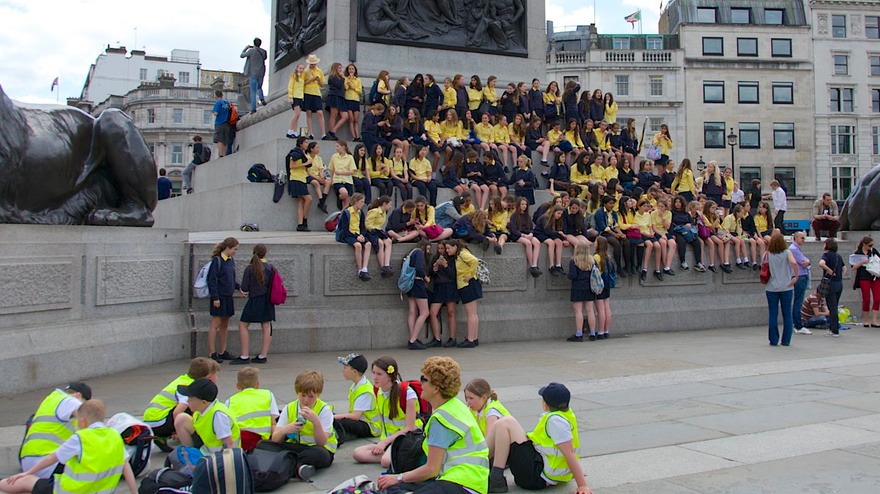
There were children everywhere! European schools continue longer into the summer than those in America, so they were still in session, and of course all the kids were off on field trips. They trooped hither, and then thither, and then yon, most of them paying no attention to anyone/anything beyond their smart phones. Exactly as you would expect. But they all looked to be having a grand time. They climbed all over the base of the Nelson Column, sat on the lions, and continually ate whatever was to hand like locusts on the march. A hoot to watch.
One fun thing – we needed to find WCs at Trafalgar Square, finally located them, and then I found that the entry turnstile to the Ladies’ wouldn’t work. So, in good American fashion, I trotted over to the Men’s side, followed by a Russian woman also in need. She looked perplexed when I started calling out to Rick, but he soon emerged. He confirmed that there was no one else in there of the male persuasion, so I took the Russian woman (about 55 years old) with me and we marched in while Rick and her husband stood guard outside. She was first confused – and then quite delighted at this innovative breaking of the rules.
The British Museum was chock-a-block with tourists. However, this did not hinder our visit much; we’re used to dodging crowded spots and coming back later (tours never stay in one place for more than just a few moments we’ve found); and it’s an amazing museum. So was the Victoria and Albert, and it at least seemed a little quieter. The V&A seems to me very similar to our Smithsonian Institution complex – what is often called the nation’s attic. The V&A is filled to the brim; stuff is parked just about anywhere you can look, with furniture and statuary and paintings and bric-a-brac from the Victorian era, ad infinitum. The British Museum seemed a bit more formally organized, but just as full of cool things. Two incredible visits. They are both impossible to see at one go, so we must go back for more!
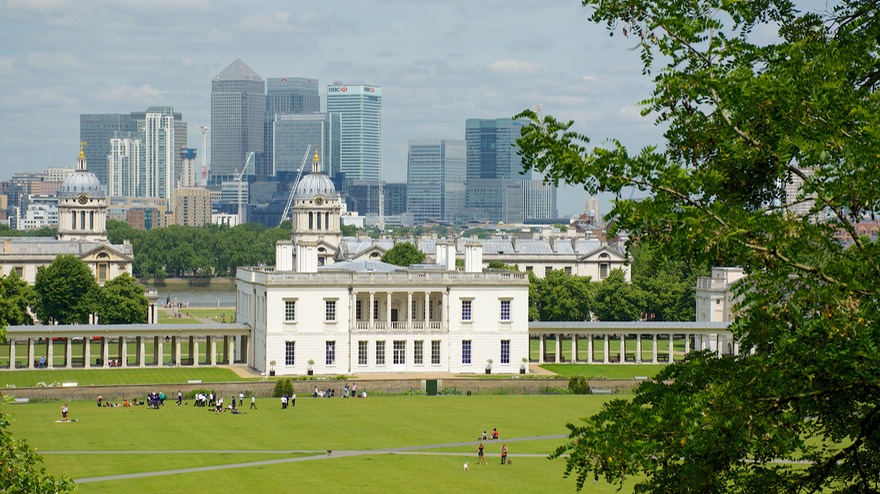
We made two trips to Greenwich, the first time by ourselves and then a week later as part of a family gathering (its own special form of chaos – read on!). It’s a lovely area, outside of London, on the south side of the Thames. The view from atop conservatory hill was great. Being quite interested in all things naval, we enjoyed being there. The Cutty Sark is moored dockside, there was a nice naval museum, and I really enjoyed a visit to the Queen’s House, a Palladian villa with a nice art collection and some of the original furnishings.
We did get frumpy when we discovered that we’d have to pay the full seven pounds each for entry to the Royal Observatory in order to get into the area to see the Prime Meridian, the line that establishes Greenwich Mean Time. We’d been looking forward to that, but weren’t willing to pay the fare, which we thought exorbitant, although it was fairly mild compared to others we would encounter along the way.
Just before we finished our time in London, we had the chance to hook up with daughter Lauri and a bunch of Rick’s British relations. In researching her British genealogy, Lauri’d made several connections, and managed (with the help of Derbyshire cousin Debbie) to get several of them into London for the day. It was a huge undertaking. All told, there were 13 of us (including 2 of Lauri’s kids who had quite foolishly decided it would be better to spend the day with their teacher and her relations than go on the organized tour for their group). They were lovely girls and we have to hope they managed to enjoy their day with us.
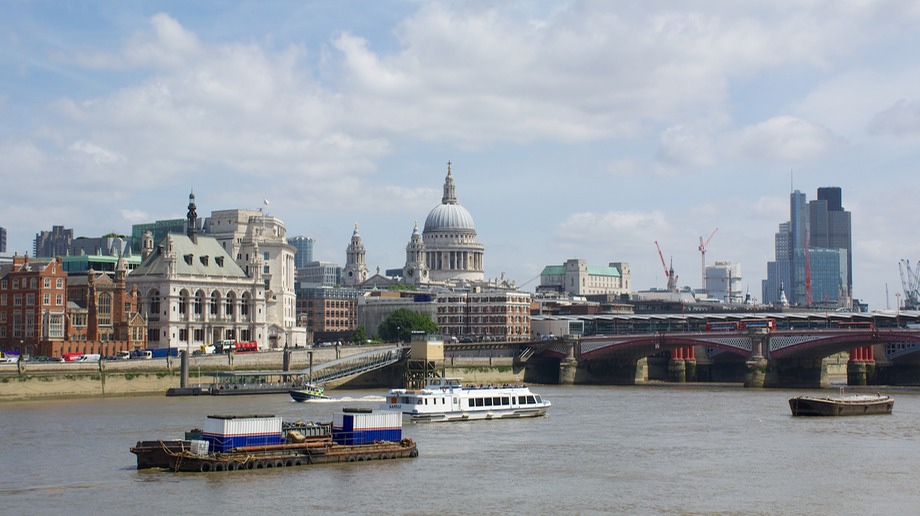
By the time we got sorted it was almost time for some to leave again, but we managed to have a few giggles, make repeated remarks about herding cats, take the aforementioned boat ride to Greenwich and back, eat fish and chips, get lots of hugs and take lots of pictures, and establish who was related to whom – and why. It was an amazing experience. Too soon we all waved goodbye, promising to try and stay in touch. Some of these folks we already knew and had longer visits with them planned for later in the summer, but others we met for the first time.
Cousin Des, whom we’d already seen once this summer, in Plymouth, had managed to join us for the day, and he and I really enjoyed our time together. He has tons of “bits” in his head about London and its history. As we rode down the river, he pointed out many sights I would have skimmed right over, which was cool. But the highlight was when, as we were wandering Charing Cross Station, he took me to see the monument to St. Eleanor which stands outside. The monument has an interesting history but, more significantly, it represents “London.” I need to explain. When you figure mileage to London from anywhere, that structure is where the mileage is given to. So if you are 23 miles from London, you are 23 miles from Eleanor. I think that’s nifty!
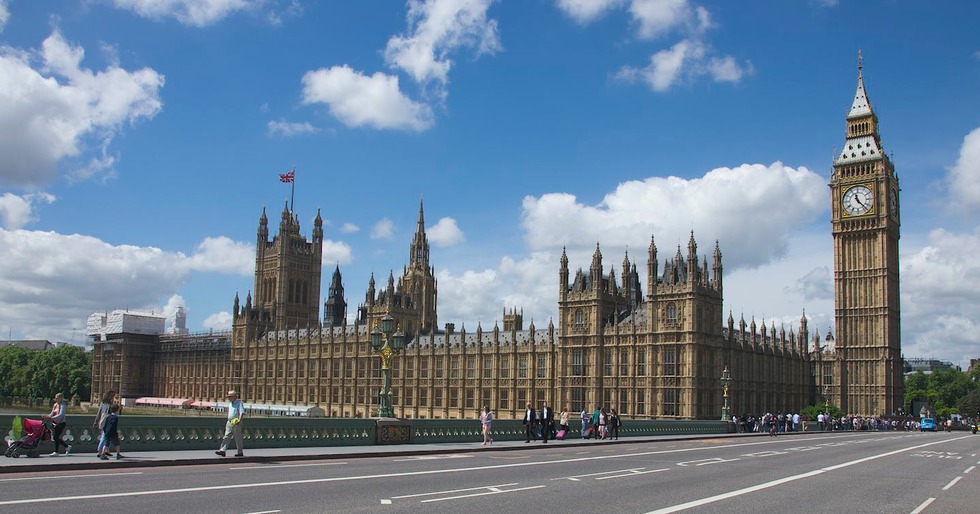
All in all, I loved London and Rick did okay, experiencing a few disappointments. We have become used to cities having an ancient or medieval center, and London of course was bombed to smithereens in World War II. The modern architecture didn’t appeal to either of us. So that was not great. Many of the “biggies” – i.e., St Paul’s Cathedral – were so badly hemmed in by other structures that there wasn’t enough space to get any kind of clear view. And, many places are distressingly expensive to visit. For the most part the museums are free, which is terrific, but St Paul’s and Westminster Abbey each carry admission fees of £17 apiece (nearly $30 each) or more, making them simply out of our price range.
The getting around was tiring – it took an hour each way just to get into the center of the city, and bus/underground travel is wearing. But there were real pleasures in sitting on the bus. We passed through many neighborhoods with very different cultures – the restaurants and stores and butcher shops featured so many different kinds of foods, and the locals were dressed in varying exotica. We heard lots of dialects of English, along with numerous foreign languages. That was grand.
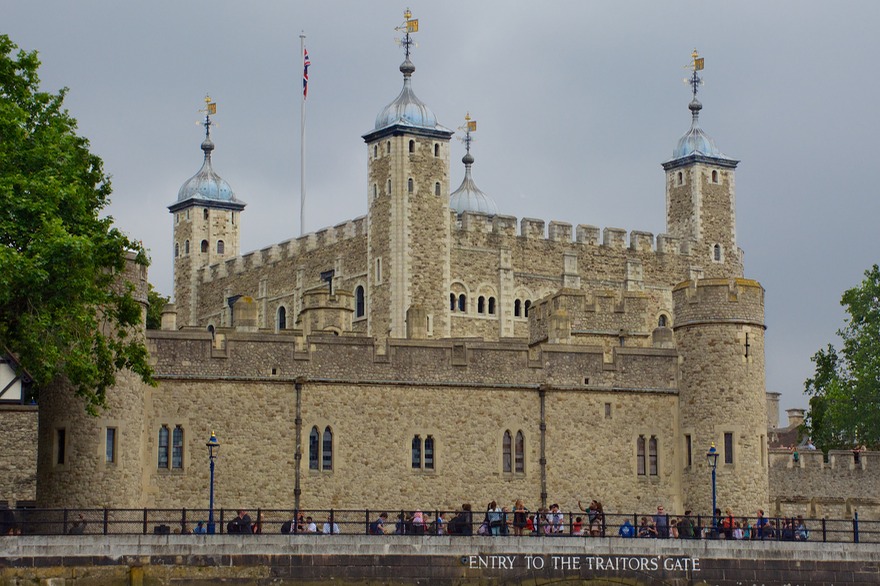
On one fast-moving bus, I watched a woman calmly sitting there putting on her makeup; I was quite impressed! There were tons of young mothers with buggies heading off to do the shopping. We passed a junk store proclaiming itself as the location of The Society for the Protection of Unwanted Objects. Cool. The World Cup was just about to get underway, and flags for England were everywhere – all to no avail as it turned out.
And we must say the transportation system was excellent. Efficient, on time, plenty of help for the novice – can’t fault it at all. We’d heard that there had been a complete revamp during the run up to the 2012 Olympics; if we were getting the benefit of that, super!
Too late to do anything significant about it, I found out why the area where we were staying was called Crystal Palace. It seems that for the 1851 Exhibition in London, a huge building of glass and wrought iron was constructed to house the event (and there is a model of it in the V&A). After the Exhibition was over, it was about to be destroyed, but a group of caring folks got up the money to have it dismantled and moved into the countryside (near where we were camped). It was resurrected (and made even larger) and sat on this site until it was destroyed in a huge fire in 1936. Only a couple of little bits remain, in a huge park area. We were told there are plans afoot to rebuild it soon – funded by a Chinese businessman. Perhaps just a rumor.
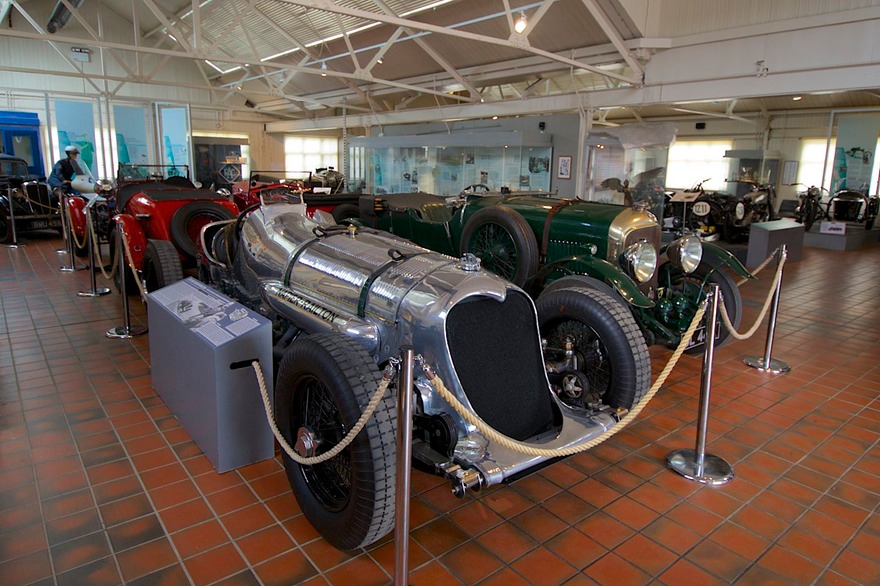
Eventually we had to get out of London. We’d spent an enormous amount of money, were totally knackered, and were ready for other things. But we are making plans to be back in the fall. We really want to see the Imperial War Museum, there’s an excellent RAF museum close to the city, and we’ve promised ourselves more time at museums. But it will have to wait until early September.
Our big goal for the summer, post London, is to spend as much time as possible in Scotland. We only had three weeks there in 2010 and are committed to much more this year. We expect to get there soon. But there are other plans as well, and we’re moving right through them, enjoying each bit.
High on Rick’s list was the Brooklands Museum out in Surrey, not far from Heathrow. Brooklands was the heart of British motor racing before WWII and lays claim to being the first purpose-built motor racing track in Europe -- back in 1906. The original course included a high-banked oval that allowed for very high speeds, and as a result the track became home to various speed record-setting attempts and a mecca for those interested in such pursuits. The Napier-Railton shown above was a record setter of some repute in the 1920s. The museum is very strong on historic ambiance and really a fun place to visit. Brooklands was built on an early aerodrome and has always included flying among its various pursuits, so not surprisingly there is an airplane museum as well. You can see our photos at Motor-Museums.com.
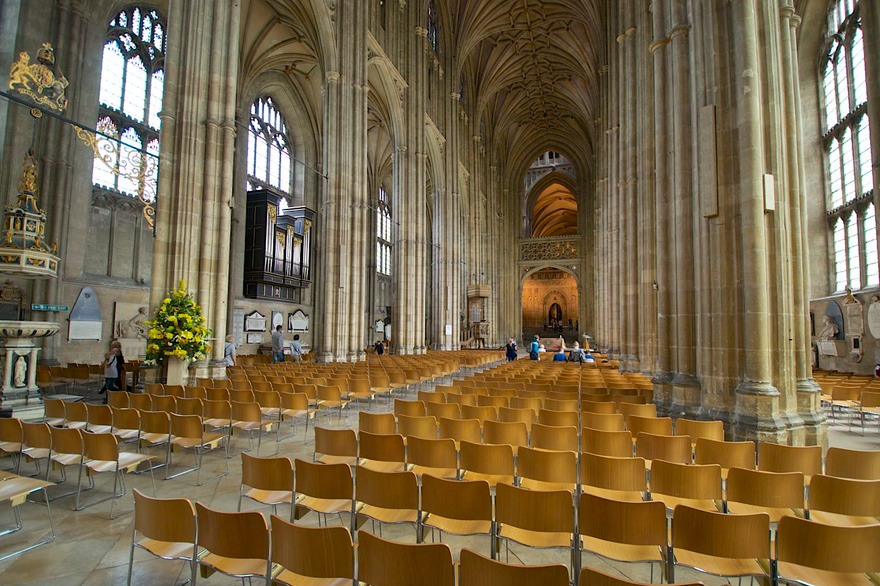
I (Kathy) had been demanding to be taken to Canterbury, another place I’d not seen during our four years’ time in Europe. So we trundled on over there, and after visiting, realized that Canterbury’s charm lies in its history. We’ve seen better cathedrals, and towns not so touristy, but you just have to get a thrill standing on the spot where Thomas à Becket was murdered in 1170, and where Henry IV and his wife Joan of Navarre are buried. As the mother church of the Church of England, the history of Canterbury is perhaps second only to Westminster Abbey, maybe not even that.
When in England, we’ve become accustomed to spending our nights parked up in spots next to fields of wheat (with rabbits and pheasants) or under forest trees (birds and squirrels), sharing small car parks with and enjoying the dog walkers that are everywhere in England. We’ve stopped in several pretty little villages, including Lavenham – “the finest medieval village in Britain” – with an awesome ancient guildhall to prove it.
We had managed to come down with colds, probably picked up in London, and were moving rather slowly, but still we managed to see some fun spots. A really great visit was to Sutton Hoo, in Suffolk, where we stopped to see the burial tomb there. We wouldn’t have known much about it except that there had been an extensive display in the British Museum. It was great to be able to go to the source. It was first excavated in the 1930’s (finishing up in a hurry as the war was coming on) and has amazing Scandinavian finds dating back to about 700 AD. Picking up again after the war, there have been several significant digs at the location, which is now protected by the National Trust.
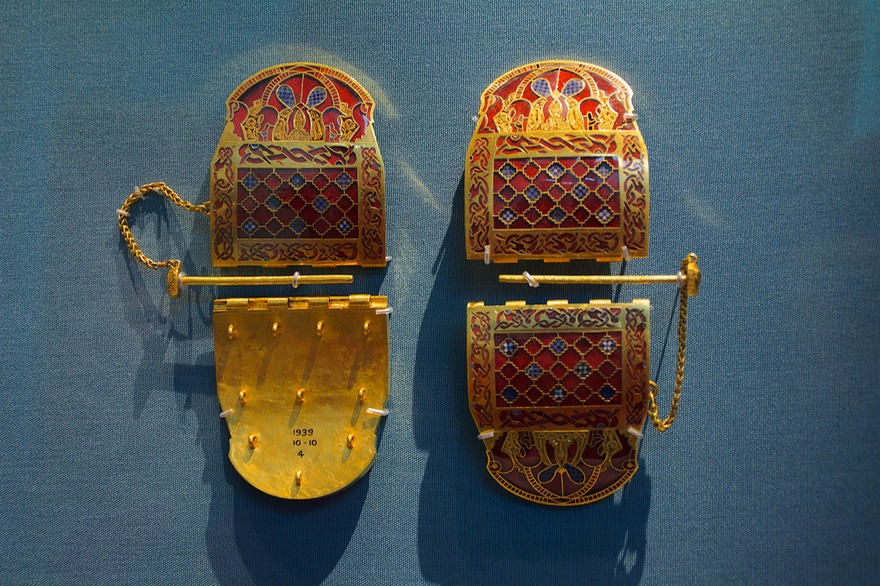
We wanted to head up to Norwich to see the cathedral there. Well, maybe not worth the effort, but the complex is in a nice setting, and the cathedral was begun in 1096, only 30 years mind you after the Norman Invasion. It was the first cathedral to be established on British soil, and was completed in only 50 years, which makes the architecture more consistient than many others. Pretty awesome, and again the history makes it worthwhile. Norwich is also full of medieval churches and has a huge Art Deco-era market area. Out of the way, but not so bad a choice, and it took us back through some lovely countryside around Cambridge and East Anglia.
Gloustershire was calling, so we trekked across the width of England and spent time in Cheltenham, where we met up with a young couple who had just bought a truck to convert for overland travel. Lauren had spotted the Tiger a couple of weeks earlier in Exeter and had contacted us through our website, inviting us to visit with her and husband Sam if we had the chance. We had a splendid evening at the local pub, where the sausages and mash were yummy, a cider fest was underway, and the music was brilliant if sometimes a trifle loud. Later on, we heard from Lauren once again inviting us to visit the family home when we are back in Devon later in the summer; naturally, we gladly accepted, particularly after being assured that Lauren’s mom is renowned for her roast beef dinners.
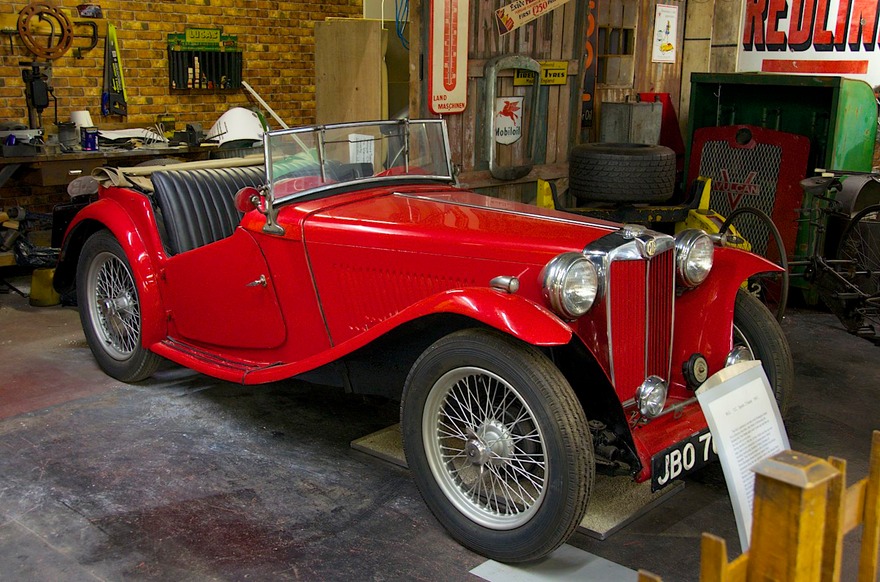
The next day we swung on up to visit relatives outside Woolverhampton (cousin Des and lovely wife Sue, along with various offspring). Three hectic days later, after visits with all and sundry in that neck of the woods, more great meals than you can safely fit into the time frame (or our bodies), and several loads of laundry – (thanks guys!) we popped over to Donington Park for Rick to get a repeat visit to the wonderful Grand Prix Museum located at this famous racing venue. We’d been here in 2010, but it was one spot Rick wanted to see again. It was a rewarding visit despite the many changes that had taken place between times. Apparently many of the cars on display come and go, as they are either on loan to the museum from other collectors or being lent out by the museum to other venues. The result is that many of the cars he went back hoping to see again were no longer there, but had been replaced by other equally interesting models. Nothing lost in the translation at all and a wonderful visit was had. Once again, you can see the photos at Motor-Museums.com.
Then, after spending a bit of time with cousin Debbie and husband Pete in Belper, Derbyshire, they joined us along with daughter Rebecca in a trek up to Manchester to see the newish (2002) Imperial War Museum North, which had recently installed an exhibit dealing with WWI and how it affected the north of England. The special exhibit was good, but the museum as a whole was even better. We couldn’t get enough of it. It covers all aspects of war – at home, the special effects on women, the aftermath, influence on science and technology, all kinds of stuff. If you’ve not considered Manchester as a destination, you might use this as an excuse. There are several great museums, the city has remade itself after the nasty bombing in 1996 when an IRA bomb destroyed much of the city’s commercial center, and it’s a cool place to be. Getting lost en route, we managed to wander past (and through) the huge Manchester United stadium, an amazing sight on its own. We really enjoyed ourselves.
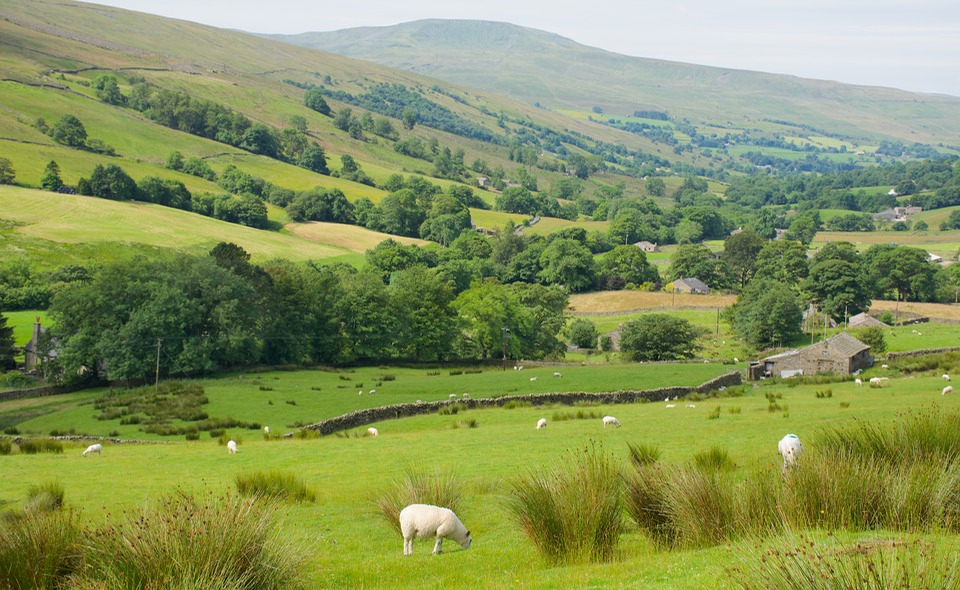
Saying good-by after a great day together, we spent the night parked up beside some sheep out in the Lancaster dales, then made a brief stop in Kirkby Lonsdale. This is a really charming medieval market town, and well worth a visit, but that’s not why we were there.
Nicky, of Nick and Nicky who run our favorite campground in Bulgaria, are Brits. She is from Kirkby Lonsdale, and had encouraged us to stop and meet her mum if we were in the area. Well, we did, and had a wonderful visit. Her mother is 83 and a bit elderly by now, but an absolute charmer. She fixed us tea and we had a great chat. Margaret has had an interesting and complex life history, and we learned a lot about England mid-century. This was a treat for us, and we were so glad we’d stopped by.
Puttering on, out of the Lake District and into the Yorkshire Dales, we were happy to be revisiting an area we’d really enjoyed before. This time, it being July, the landscape was in full bloom and enjoying beautiful summer weather. We wandered along the Dentvale, through Dent and up over the Garsdale Head Grade (1850 feet at the top – our highest yet in England), eventually ending up in the small town of Hawes. We’d been here before and had found it charming. Still is. Added attraction? The Tour de France had come through a week earlier as part of its Yorkshire leg, and there still were flags and welcoming signs and special sales and folks – in cars, on cycles, and riding motorbikes -- galore and everyone was having a ball. (This was true all over Yorkshire, but in Hawes it all seemed to be happening at a higher pitch.)
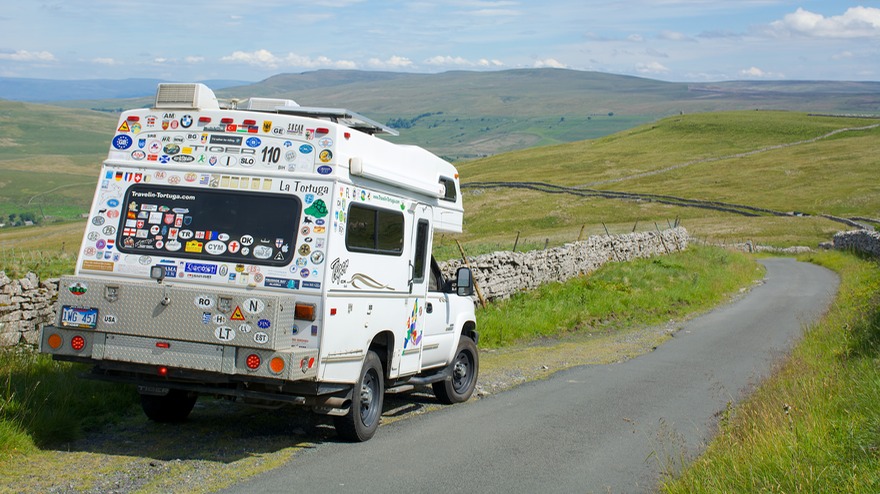
We finally wandered on, after soaking up some of the residual excitement of the big event. Several times we were on the small roads through the Dales that had been used as part of the race. The cyclists were in great abundance, following in the wake of the great, and we saw lots of markings on the roadbeds that are part of the race. It was a lot of fun. Friends had come to Hawes a week earlier (we just missed them) to watch the event itself, and later we got together with them and learned more about their experience.
We found ourselves back in the vicinity of the same military training area we had camped next to four years back, and decided to stop again. As before, there was a shooting range nearby; this time it was more active. On Sunday morning, it was absolutely full up -- with civilians; with the Scottish independence vote on the horizon, we cheekily wondered if the fellows were getting in shape to keep out the northern hordes…
Signs along the roadway were explicit that we should “Keep to the Roads” – we were happy to comply. Another, perhaps less ominous sign warned of an imminent “Heavy Plant Crossing” and we started keeping a lookout for humongous rhododendrons on the loose. In the end, no threatening flora were observed.
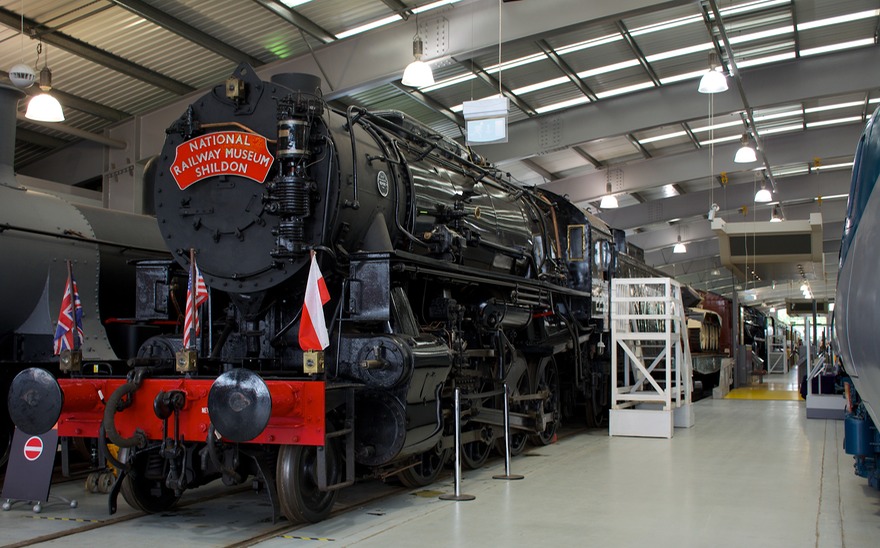
Wanting to keep making progress, but knowing we could have stayed in the Dales for weeks on end, we finally meandered past Richmond, heading for Durham. Along the way we made an interesting stop at Shildon, home of a branch of the National Railway Museum located there. Shildon is historically significant because the first passenger train in the world left from there in 1825, making it the world’s oldest railway town. In the reality, the history was perhaps more interesting than the museum itself, but there were several very cool things to look at. It mostly deals with steam engines, and we were quite taken with the Sans Pareil, an engine built in 1829 by engineer Timothy Hackworth, who was in charge of the development of the railway under the direction of the more famous, George Stephenson. Also fun were a couple of miniature steam operated locomotives being displayed out in the parking lot. They had hard rubber wheels so they didn’t need tracks and they puttered around a bit and mostly just sat with their coal fired steam engines bubbling along. Very pretty little things, and each of them hand made from scratch by their proud owners.
On to Durham, which was a total, and delightful surprise. This is a really great city. It has a splendid cathedral, which we liked a lot; a castle which others said was great but we didn’t visit; is easy to walk around; sits marvelously on a bend in the River Wear; and is home to Durham University, third oldest in England (after Oxford and Cambridge). The old city has a great vibe. Sadly, we missed (by one day) a weekend’s worth of their annual Brass Festival. We toyed with hanging around until mid-week when there would be more events, but eventually moved on. Please put Durham on your list of must-dos when in northern England.
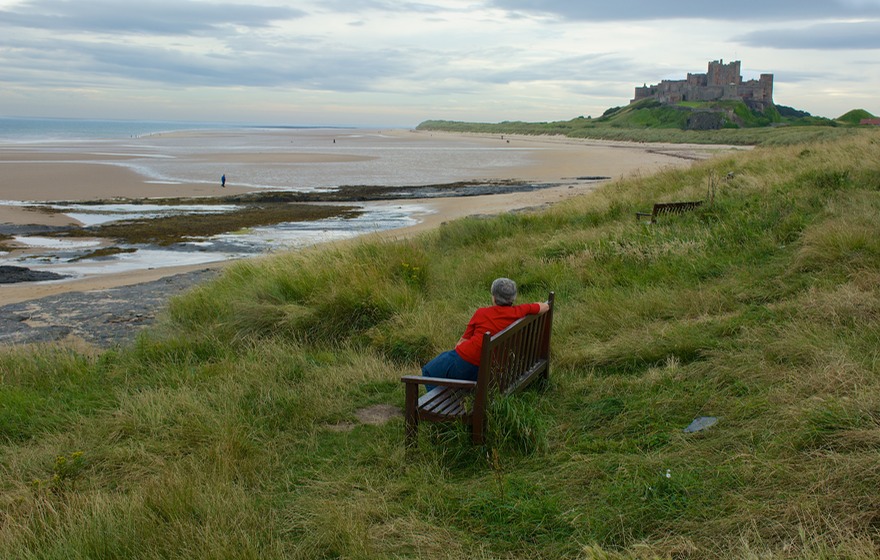
Heading toward Scotland in earnest now, we had but one last area to visit first – the Northumberland coastline. We wanted to detour around Newcastle-on-Tyne (due north of Durham), that huge coastal metropolis, so we ducked inland a bit. (For those of you familiar with that region, it meant we also bypassed the city of Washington, home to Himself’s forefathers, but that was okay by us. Sorry.)
This route gave me a chance to see a bit of Hadrian’s Wall again. If you don’t already know, this is a wall that was built starting in about A.D. 122 that goes right across Britain at this point. It’s about 75 miles long and was intended either to keep out the murderous hordes or to provide a point for taxation on trade with selfsame hordes, depending on whom you ask. There’s something about that sucker that really gets me, so Rick found a spot for me to climb up on top and I danced around while he took pictures. Silly me. But great.
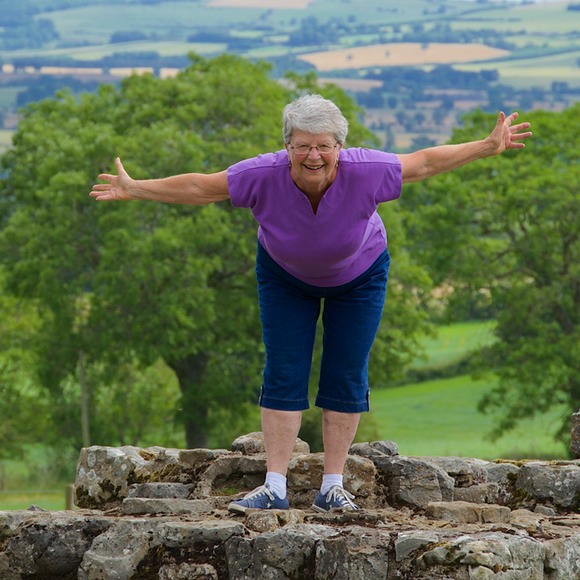
Ducking back to the coast again, we made a short-ish but very pleasant Ruined Castle Tour as we made for the border. Warkworth, Dunstanburgh, Bamburgh and Holy Island all have significant and interesting ruins to be visited or, in our case, viewed from afar (but close enough for great pictures). We enjoyed each of them, spending a night part way up parked along the beach just north of Bamburgh. Bamburgh also yielded a delightful lady sitting beside the path towards the castle. She had a variety of wild berries available – gooseberries, as well as both black and red currents – and I’ve been enjoying my purchases ever since. Berries freeze well.
A couple of hours later we popped across the Scottish Border and immediately knew we’d returned to a very special place, one that’s very dear to us. And all is well. We’ll tell you all about our visit later on.
So long for now; Kathy and Rick
Click to see more photos from England